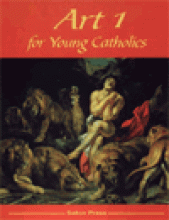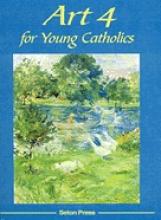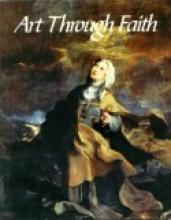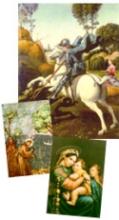Art Text
Art 1 for Young Catholics
This course follows the liturgical year. It begins with Advent. There are a total of forty-four projects. Each one has an explanation.
***EXAMPLE OF LESSON*** For example the next one we are going to do is "The Grotto at Lourdes" on pg 12. It begins with "Celebrate - February 11, OUR LADY OF LOURDES. February 11 is the anniversary day of the first apparition of Our Day at Lourdes, France. The Blessed Virgin Mary appeared to a 14 yr old girl named Bernadette Soubirous eighteen times between Feb 11 and July 16, 1858. On March 25, 1858, Bernadette asked the beautiful lady to identify herself. Mary answered, "I am the Immaculate Conception." Mary also asked for penance and prayer. Bernadette was told by Our Lady to have a chapel built there and to have people come in precessions. A miraculous spring of fresh wat4er came forth from the ground and to this day, many people have been cured by the healing waters that come from the spring.
The lesson then has suggestions for the parent to find more info on the topic. Then the project is listed. In this case we need Pattern # 10, glue, scissors, green and red tissue paper, brown, green and yellow construction paper, crayons or markers and gold glitter. The instructions are giving in steps. 1. Color the picture of the Blessed Virgin Mary. Drape glue on the halo and roses at Mary's feet. Sprinkle with glitter. 2. Cut out patterns for the grotto, oval and vine. 3. Place grotto pattern on brown paper, trace and cut one. 4. Place oval pattern on yellow paper, trace and cut one. 5. Place vine pattern on green paper, trace and cut two. 6. Set grotto pieces aside. Glue oval in the center and glue the two vines along the sides. 7. Cut layers of green and read tissue paper into 1 1/2" X 1 1/2" squares. You will need more green than red. 8. Take each individual red square and roll into a loose ball. Glue them here and there on the vines to look like roses. 9. Take each individual green squares and slightly crumble it. Glue them to vine around roses to look like leaves. 10. Cut out figure of Mary and glue it in center of the oval. 11. Using a pen, carefully print OUR LADY OF LOURDES across the top of the grotto. Display your artwork. *************
We are excited about this lesson because we just set up a table to use as a home altar and so far only have a few votive candles. We want to save for a nice stature of the Sacred Heart and Immaculate Hearts. So until then the Grotto the kids make will grace our little table.
The other lessons cover all twelve months. There are projects for Lent, Easter, St Pat's Day, Pentecost, Ascension Thursday, Trinity Sunday, Assumption of the Blessed Virgin Mary, Feast of All Saints and more. We have really enjoyed it. I have no artistic ability and this helps me to give my children art that looks like art ;-). I have also learned alot about the liturgical year from it. Also Cari and David have been able to do it together. I plan on using it again next year for projects for liturgical feasts. It really is a wonderful book.
Art 4 for Young Catholics
What could be better than a well-planned and well-organized Catholic art textbook written by internationally-known Catholic artists who are also art historians and professors? This is the textbook! From the introduction by the authors: "The rules used here have been the time-tested tools used by artists for centuries and are based on natural law and common sense. Once acquired, these skills are not only transferable to other disciplines but also foster genuine appreciation and discernment in the field of art and of beauty in creation."
Seton's Art 4 for Young Catholics includes 36 weekly lessons for upper-elementary aged children. The lessons build upon one another, with a few lessons carrying over from one week to the next. Unlike some of the other books in the Seton art series, the lessons do not follow the liturgical year and could be used in an order other than the way they appear in the text. Each lesson plan includes the objective of the lesson, a detailed list of required materials that are easily and inexpensively available, and step-by-step instructions with many illustrations to show the student and teacher what is expected. Art history and appreciation topics are featured in several lessons with thirteen full-color plates and numerous black-and-white plates for careful study. Topics of instruction range from line, contour, texture, color, symbolism, contrast, dimension, symmetry, to balance and design.
Although the book is sold as the text for Seton's 4th grade, it is very appropriate for children up through the 6th grade for a multi-level homeschool class or co-op. I've been using this course this year very successfully with an art-talented 3rd grader and an art-challenged 6th grader, and I'm thrilled with it. Not only are my students developing basic art skills and basic art sense, they are also being introduced to traditional art works featuring Catholic subjects.
Art Masters Enhance Religion
Art Through Faith
This Catholic Art text, intended for the eighth grade, offers thirty-six weeks of lessons in art appreciation, with an emphasis on religious art. The text presents 152 images (in full-color on glossy paper) which cover many of the basic schools and famous artists (in chronological order). Descriptions offer biographical sketches of famous artists, explanations of various art forms (such as icons, mosaics, statuary, church architecture, etc.) Although the focus is on religious art, there are a few non-religious subjects as well, such as the cave paintings from Lauscaux, France and The School of Athens by Raphael.
Although the book is intended for eighth grade, it is the sort of book that could be used for a family-wide art study. My five year old son, who is quite the art afficianado, enjoys paging through the book. When asked for a quote about the book, he had this to say: "The pictures are really colorful. It has a Michelangelo picture in it. There's a picture by Leonardo da Vinci in it. There's one by Raphael called The School of Athens. I like it."
Copyrights 1996/1999
Learning to Appreciate Art
Used with the Catholic Heritage Curricula Fourth Grade Lesson Plans
This lovely, well-written art resource offers an excellent introduction to composition, perspective and form; various kinds of art (mosaic, fresco, sculpture, etc.); a brief history of early art (including cave paintings, Egyptian and Greek art); and a detailed account of a number of major artists of the Renaissance and pre-Renaissance (Giotto, Fra Angelico, Botticelli, Leonardo da Vinci, Michelangelo and Raphael). Through art reproductions, simple line drawings and engaging text, the child will be drawn into a surprisingly in-depth way of looking at a work of art. I was especially impressed by the "Appreciating Art" segments that follow the works of some of the artists. These give step-by-step ideas, questions and hints to get more out of each picture and learn to appreciate the strengths and uniquenesses of each artist.
The individual art reproductions - representing the Master artists listed above as well as examples of different historical periods and types of art, are intended to be placed in the book by the student (there is a miniature black and white reproduction of each piece so the task is quite easy to do). This type of active involvement helps a child to take the material "for their very own" in a way that simply reading and looking at a book doesn't always accomplish. The Catholic material is interesting and well-connected to the subject - especially in a world where most children's art materials are devoid of religious or even classical subjects.
What our family did was to move this appendix into its own binder. We laminated the art reproductions and keep them in the back of the binder to allow our children to match them up with the appropriate spot over and over again (a Montessori sort of thing to do). It also allows older and younger siblings to enjoy this resource. This is a really lovely resource - one of the nicest materials I've come across in awhile. I learned some new things from the text too. Do you know why Leonardo da Vinci's Last Supper was so faded in comparison with other works from the same general time period (like the Sistine Chapel)? Or why the very famous pair of thoughtful angel cherubs were placed at the bottom of the Sistine Madonna by Raphael? Well, I won't tell you, but you'll find these and lots of other interesting tidbits in this very nice and highly recommended text.
Meet the Masters
Years ago, a friend who teaches university-level art classes, told me that the best way for me to teach my children art was to combine how-to instruction with art appreciation. She suggested learning about the life of a particular artist by reading biographies and then learn how to imitate his or her technique. This made perfect sense to me, but I did not feel knowledgeable enough in the subject matter to put together my own curriculum and I did not know of any such art program that could be used in the home.
Enter Meet the Masters. This program integrates how-to instruction with art appreciation.
To review Meet the Masters, I invited two other families to join me and my children in using the program, forming a co-op of sorts. My desire was to get a feel of the program myself, as well as see how other families responded to the instruction. I am happy to report that our little art co-op was very successful.
In the first lesson the children learned about the life of Vincent Van Gogh, through the CD-ROM that comes with the program and the Internet. All of the children gathered around me and the computer, as I read from the script that comes with the program. It is good that Meet the Masters provides scripted instruction, as my personal knowledge of famous artists is admittedly limited. I learned about the life of Van Gogh alongside my children.
After reviewing Van Gogh's biography, we moved to the dining room table where we learned about his art technique and the children could mimic it. The program provides careful instructions on how to help the children with the lesson. It also provides a supply list and set-up instructions, so I was well prepared before our friends arrived.
I enhanced the program a little by searching out more of Van Gogh's artwork on the Internet and even saved one of his paintings to use as "wallpaper" on the children's computer (just left-click on the picture). That way every time the children booted up the computer, they were treated to a beautiful piece of art. I also picked up a children's biography at the library.
We met with our friends every other week until the program was finished. During that time we learned about Mary Cassatt, Piet Mondrian, Pablo Picasso, Claude Monet, and Winslow Homer. My children and the children of my friends (ages seven to twelve) all enjoyed the program and were even heard speaking about things such as texture, complementary colors, contrast, and the such throughout the weeks. On more than one occasion, my children recognized, and were excited to see, prints of the artists that we studied while visiting friends' homes or the doctor's office.
Though I do like this program very much, I am disappointed at the high price tag. It is expensive and parents must weigh the benefits with the cost carefully. However, the publisher does offer a generous discount if customers order more than one grade level at one time. A computer with a CD-ROM and Internet access is necessary to use Meet the Masters.
Note: This review is a bit out-dated. You can look at their current offerings here: http://meetthemasters.com/






